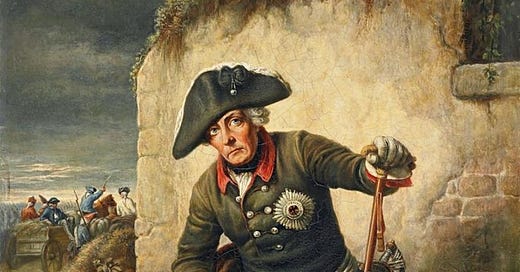Towards the end of his life, Frederick the Great won his last, and, by the standards of his age, most perfect, victory. Known, when remembered at all, for the complete absence of battle, the War of Bavarian Succession (1778-1780) ended, as most wars do, in a compromise peace. That is, while Frederick achieved his chief aim of preventing the expansion of Habsburg influence within the Holy Roman Empire of the German Nation, he yielded on a number of secondary matters, to include the question that gave the conflict its name.
No analogy, least of all one which compares events separated by the fourth part of a millennium, is perfect. Nonetheless, I find myself struck by several similarities between the present war in Ukraine and the aforementioned struggle. These include the the reluctance of the chief belligerents to take great risks, the consequent absence of battle, and the likelihood of a compromise peace once one (or both) of the major players runs out of money.
An “absence of battle” should not be confused with an “absence of fighting,” let alone human suffering. There was much “small war” [Kleinkrieg] in Frederick’s last war, with consequent casualties to both soldiers and civilians. Foraging on the part of operationally idle soldiers, moreover, did considerable damage to the stocks, flocks, and fields of the places where armies set up housekeeping. Indeed, the frequency with which soldiers dug up edible tubers led some contemporaries to call it the “Potato War” [Kartoffelkrieg].
With all due deference to those who write about (and wargame) the “Battle of Kyiv,” the fighting that took place in the vicinity of the Ukrainian capital in February and March of 2022 may have been a raid, a parade, or a bungled Blitz. Whatever it was, it cannot be described as a “battle” without inflicting injury to the definition of that word. Likewise, the multi-month struggle for the Azov works in Mariupol is best described as a siege. Finally, the fight around Bakhmut has been, in effect, a long series of what Frederick would have called “cannonades,” albeit of a scale and intensity that would have boggled his pre-industrial mind.






This touches, maybe not directly but at least tangentially, on an issue long extant in American military culture but never adequately addressed educationally or institutionally: the reality of the "small wars" and how they're fought compared to the major ones. Our martial culture, such as it is, is built, rationalized, and mythologized around "the big battles" and that all conflicts have a good guy and a bad guy with clear desires on both sides. The world doesn't look, or act, that way. Most wars look more like the War of Bavarian Succession than they do World War II...but we spend most of our time studying that one (and ones like it). I don't know how we change that effectively with a lasting impact, but it's one we do need address
Are you suggesting there's been more than one German political leader in history? And that his example is also of interest when looking for analogies with the present? Sounds like misinformation to me.